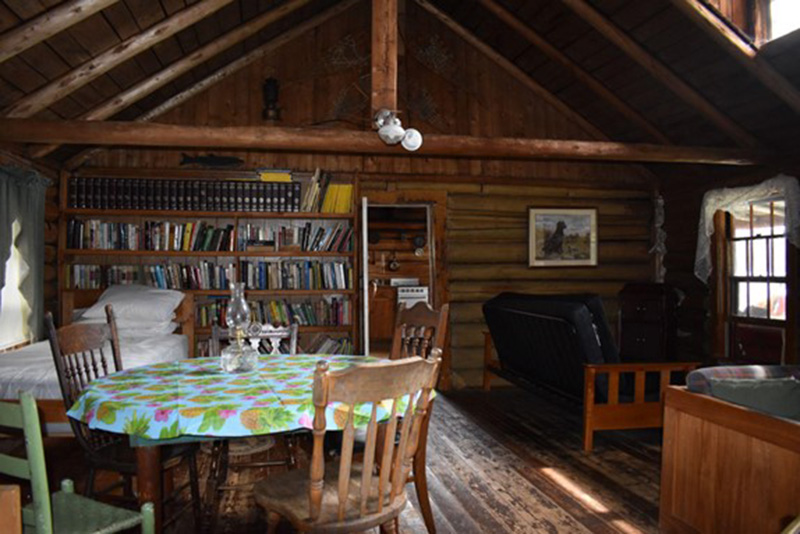Sporting and Leisure Camps of Central and Western Maine
by Catherine Cyr
With help from a Decorative Arts Trust Research Grant in 2021, I traveled throughout my home state of Maine to explore the architecture and history of early camps for my Master’s thesis through the Winterthur Program in American Material Culture. The term “camp” is used in Maine to refer to small, rustic cabins and cottages that operate as leisure accommodation structures. Camps are typically built alongside bodies of water in the interior portion of the state and meant to provide access to a plethora of natural resources. These structures provide remote getaways and facilitate popular outdoor activities, such as hunting and fishing. The construction of camps in the wilderness of Maine played a significant role in developing the state’s tourism industry in the late 19th and early 20th centuries. Today, camps continue to serve as an essential component of the Maine summer experience, including my own.
My summer fieldwork focused specifically on two areas—Central and Western Maine—as previous scholarship has inadequately explored the architecture and design of camps away from Maine’s coastline. The purpose of my investigation was to define the notable and reoccurring architectural elements that appear in the construction of camps. As a result, I used my research to establish the framework for a type of vernacular architecture inherent to Maine. Ultimately, my thesis advocated for the continued study and preservation of camps and encouraged the state to begin the process of designating extant late 19th- and early 20th-century camps as historic structures.
My fieldwork included over a half dozen sporting and privately-owned family camps with established histories. At each site, I noted the camp’s construction and materials, as well as sightlines and surrounding landscape. When possible, I stepped inside the buildings to better understand their floor plans and décor. I took exterior and interior measurements in addition to numerous photographs to further document each camp. I spoke with camp owners and visitors to learn about the histories and family stories associated with each site. I also spent time in local historical societies when traveling, uncovering photographs and ephemera related to the camps I visited, as well as those that no longer remain standing.
One of the highlights of the summer was a visit to Spencer Pond Camps located northeast of Moosehead Lake. Their largest camp building, Sabotawan, was built in 1901 by Mose Duty. Nestled along on the shoreline of a pond known for its frequent moose sightings and loon calls, Sabotawan began its life as the year-round home of Mose and his wife, later becoming the centerpiece of a sporting camp in the late 1940s.
The log cabin has retained many of its original architectural features and demonstrates both traditional and vernacular log construction techniques. The interior features extant elements such as cast iron stoves, a water pump, and gas lamps as the camp remains without electricity and running water to this day. The decor and furnishings are rustic and simple, reminding visitors of their wilderness surroundings with a taxidermied deer head and snowshoes hanging in the den. But comfort and practicality is also taken into consideration as guests can look forward to cooking and eating meals in the kitchen using the vintage ceramic dishware stored in old cupboards and sleeping in the large, early 20th-century sleigh bed in the main bedroom after a long day of hunting or fishing. Walking into the camp felt like stepping back in time and, although the camp has seen some necessary renovations over the years, many demonstrating a sense of classic Yankee ingenuity.
The Trust’s generous funding was instrumental in supporting my thesis and broader work concerning the architecture and material culture of Maine. I look forward to continuing this research in my new position at Maine Maritime Museum, where I plan to launch an exhibition in 2024 exploring the culture surrounding Maine camps, outdoor recreation, and interior waterways.
Catherine Cyr was a Lois F. McNeil Fellow in American Material Culture at Winterthur Museum, Garden & Library from 2020-2022. She is now the Exhibition Coordinator at Maine Maritime Museum. Her research on Maine camps will be the basis for a large-scale exhibition at the museum in 2024.
About The Decorative Arts Trust Bulletin
Formerly known as the "blog,” the Bulletin features new research and scholarship, travelogues, book reviews, and museum and gallery exhibitions. The Bulletin complements The Magazine of the Decorative Arts Trust, our biannual members publication.
Click Images to Enlarge
Did you know that clicking on the images in Bulletin posts will allow you to get a closer look? Simply click on an image, and a larger version will open in a pop-up window.










